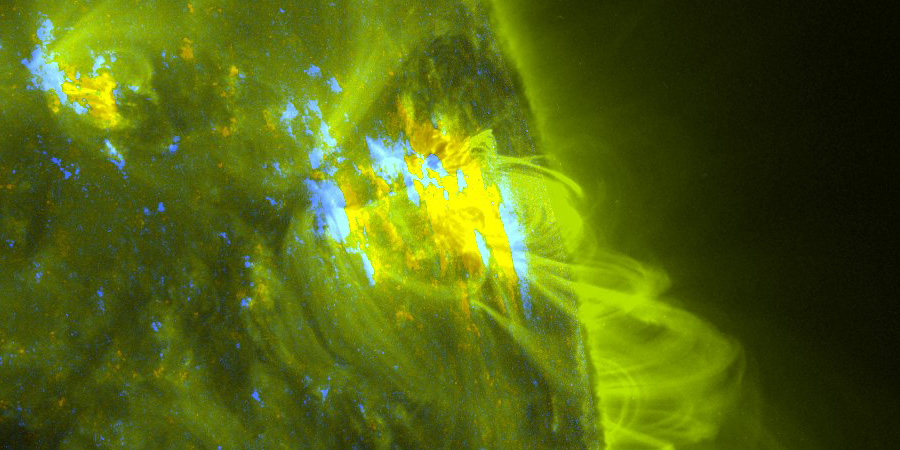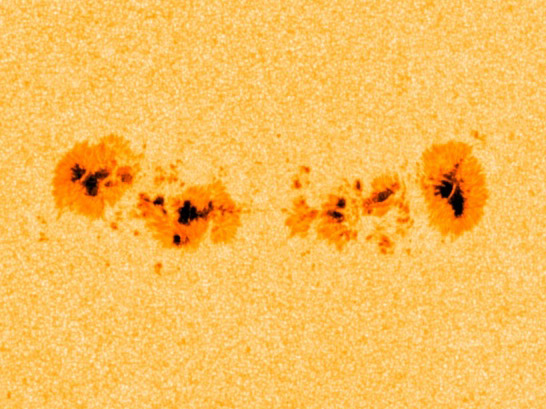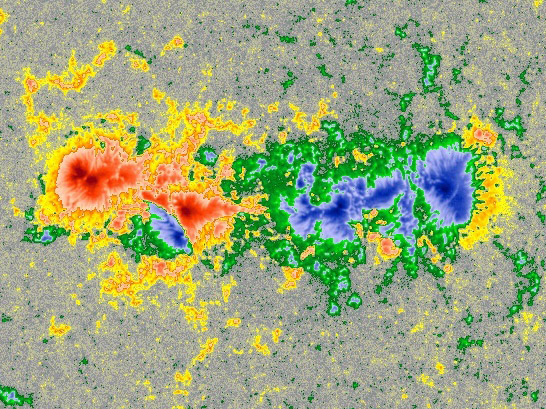Four M-class solar flares, Sunspot region 2645
Monday, 3 April 2017 00:47 UTC

Solar activity was at high levels yesterday (2 April 2017) as our Sun produced four M-class solar flares! The strongest of these solar flares was an M5.7 solar flare (R2-moderate) that peaked at 20:33 UTC.
All of these M-class solar flares came from sunspot region 2644 which is close to the west limb of the Sun. Because it is so close the western limb, it is hard to analyse the sunspot region but it is clear that it grew rapidly the past two days and obviously developed a complex and unstable magnetic layout. More M-class solar flares remain possible today from this sunspot region but any eruptions are likely not going to be Earth-directed. Here is a list of all the solar flares that took place yesterday:
| Region | Start | Maximum | End | |
|---|---|---|---|---|
| 2644 | B4.8 | 00:26 | 00:29 | 00:31 |
| 2645 | C1.0 | 02:06 | 02:10 | 02:13 |
| 2645 | C8.0 | 02:41 | 02:46 | 02:48 |
| 2644 | C1.2 | 04:55 | 04:58 | 05:00 |
| 2644 | M5.3 | 07:50 | 08:02 | 08:13 |
| 2644 | M2.3 | 12:52 | 13:00 | 13:11 |
| 2644 | C3.0 | 16:20 | 16:27 | 16:38 |
| 2644 | M2.1 | 18:18 | 18:38 | 19:28 |
| 2644 | M5.7 | 20:26 | 20:33 | 20:38 |
Coronal mass ejections
So what about the coronal mass ejections from these solar flares? We already concluded that the M4.4 solar flare from 1 April 2017 produced a coronal mass ejection that is heading away from Earth.
We still do not know for sure about the coronal mass ejections from yesterday's M-class solar flares due to a lack of SOHO coronagraph imagery. There are some new frames available from the M5.7 coronal mass ejection but this coronal mass ejection looks to be heading well west and away from Earth as well.
It is still uncertain if the M5.3, M2.3 and M2.1 solar flares produced coronal mass ejections and if they did, if they are earth-directed but based on the trajectory of the coronal mass ejections from the M4.4 and M5.7 solar flares, any coronal mass ejections from these solar flares are also very likely not directed towards Earth. That means we must shift our attention to the only sunspot region which could send a plasma cloud our way: sunspot region 2645:
Sunspot region 2645
Sunspot region 2644 is stealing the show but we should not forget about sunspot region 2645 which is still facing Earth. An eruption from sunspot region 2645 during the next 24 hours would likely be earth-directed! This sunspot region is however fairly quiet with only a very impulsive C8 solar flare yesterday being its biggest achievement.
It might be quiet but it is a sleeping giant. It has a complex Beta-Gamma-Delta layout with a magnetic delta sunspot in the trailing portion of the group. There is however little movement and spot development which might explain its stable magnetic layout and lack of flaring. We do however need to keep an eye on this region as it is capable of producing an M-class solar flare.


Thank you for reading this article! Did you have any trouble with the technical terms used in this article? Our help section is the place to be where you can find in-depth articles, a FAQ and a list with common abbreviations. Still puzzled? Just post on our forum where we will help you the best we can!
Latest news
Latest forum messages
Support SpaceWeatherLive.com!
A lot of people come to SpaceWeatherLive to follow the Sun's activity or if there is aurora to be seen, but with more traffic comes higher server costs. Consider a donation if you enjoy SpaceWeatherLive so we can keep the website online!

Space weather facts
| Last X-flare | 2024/03/28 | X1.1 |
| Last M-flare | 2024/04/18 | M2.2 |
| Last geomagnetic storm | 2024/04/16 | Kp5 (G1) |
| Spotless days | |
|---|---|
| Last spotless day | 2022/06/08 |
| Monthly mean Sunspot Number | |
|---|---|
| March 2024 | 104.9 -19.8 |


